Japanese Samurai Katana Iron Tsuba Kobuse Sword Folded Steel Blade Real Hamon —
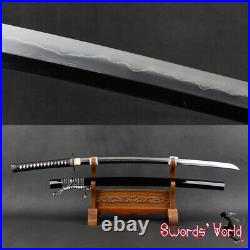
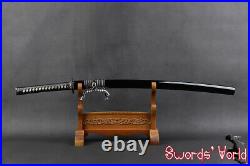
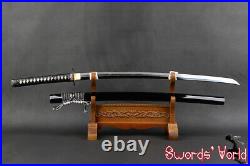
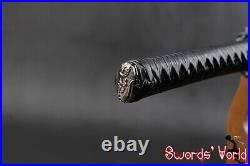
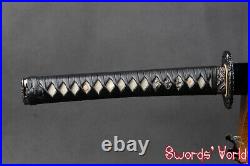
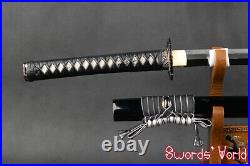
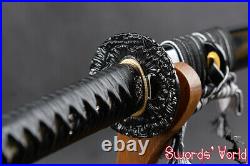
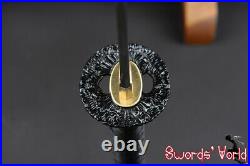
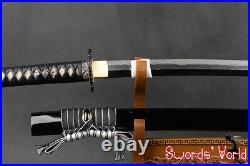
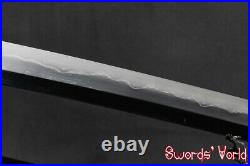



You may also like. Japanese Samurai Katana Iron Tsuba Kobuse Sword Folded Steel Blade Real Hamon. Samurai katana as a weapon is famous for its beautiful shape. They are used as art collection and the symbol of samurai soul. Our sword allows you to make a collection or to send to friends as a present. 103 cm / 40.6 inch. 70 cm / 27.6 inch. 26 cm / 10.24 inch. 3.2 cm / 1.26. 0.7 cm / 0.28. Fully hand forged, hand polished Shitaji togi +. , clay hardened, water quenching. 1095 carbon steel, folded forged 15 times. KISSAKI: medium tip (chukissaki). Real hamon, clay hardened line. Black genuine leather cord. Black & white specialized cord. Glossy black lacquered wooden scabbard. 1 sword with saya. 1 1-layer black wooden stand. The kobuse is constructed of two different kinds of steel, the core steel and the outer steel, where the core steel is wrapped with the outer steel. As to the tempering, the outer steel is more sensitive than the core steel. In this case the outer steel is harder than the core steel. Before being quenched, a special clay mixture can be applied onto the blade to harden the edge and obtain different hardness on the blade. The clay mixture was a special recipe and considered a crucial trade secret, guarded protectively by sword making masters. It would contain such things as feathers, powdered bones, grass, etc. And would be applied to the edge of the blade before being quenched. During quenching, a chemical reaction between the clay mixture and the hot steel occurs during the sudden temperature drop and carbon is fed into the blade in. High amounts, creating an extremely tough edge. A clay hardened blade can only be quenched in water, thus increasing the defect rate even more. Another way for clay tempering is to apply clay along the blade but let edge exposed. Thus, while quenching the blade into water, the uncovered edge will cool down suddenly, but the rest of blade will cool down slowly. Such differential temperature change results in the different hardness of the blade. So the edge is tough enough to cut, where the back of blade is soft /flexible enough to absorb the impact during cutting. Such quenching process usually will leave beautiful wavy tempered line on the blade, as known as “hamon” in Japanese swords term. Is divided into two stages. Is Foundation polishing, to correct any bends in the blade. Is the stage that places the mirrorlike finish on a blade. This sword used Shiage togi. It is a elaborate process to the blade, it uses small grindstone to polish the blade by hand to make the blade mirrorlike, it is a time-consuming work, it can effectively increase the sword’s monetary, historic, artistic, and functional value. The Modern Style Polishing Hadori Style Polishing?? It is designed to highlight the aesthetics of the blade. In this style polishing, the hamon appears white against the black, shining steel and the mirror finished shinogi-ji. It is so aesthetic that it makes a blade perfect for display. The white pattern that looks like hamon is called “HADORI”. It is not a true hamon, but it is designed by polisher along the hamon to exaggerate it. When you look at the blade under a proper light, you can see the true hamon under the hadori. With the modern polishing style, you can see the blades with aesthetically “made-up face”. This polishing style was developed by a famous polisher in the early 20th century. International Buyers – Please Note. We are one of the sowrd manufactures in Longquan China where is famous for sword making. We can change some fittings of the swords if you need. We can engrave your name on the blade for free. We are not a reseller, so the price is competetive. All of our swords are handmade. Don’t worry about the quality. Please contact with us before you leave feedback. We will try our best to solve the problem for you, thank you. Sometimes, you may not get our reply immediately due to the time difference among each country. However, please be assured that we’ll strive to reply you as soon as possible once we got your messages. This item is in the category “Collectibles\Knives, Swords & Blades\Swords & Sabers\Asian\Japanese”. The seller is “lqshijian2014″ and is located in this country: CN. This item can be shipped worldwide.
- Type: Katana
- Handle Material: Cord Wrapped
- Tang: Full
- Dexterity: Right-Handed
- Edge: Single, Curved
- Handedness: Double-Handed
- Authenticity: Original
- Country/Region of Manufacture: China
- Theme: Samurai
- Brand: SJ SHI JIAN
- Color: Black
- Blade Material: Damascus Steel

Categorised as: japanese
Comments are disabled on this post